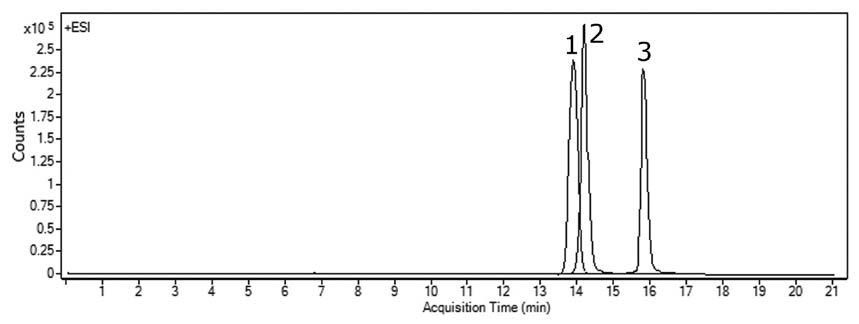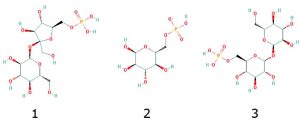Sucrose-6-phosphate, Glucose-6-phosphate, & Trehalose-6-phosphate
Central Metabolic Intermediates in Plants
Sugar Phosphates are very highly polar Metabolites and may be difficult to retain using traditional Reversed Phase Methods. In addition, S6P and T6P are Isobaric Compounds so it is very important to separate these two Phosphorylated Sugars for MS Detection. G6P is easily distinguished by its mass to charge ratio (m/z).
These three Phosphorylated Sugars were separated using this Method even though the separation is quite challenging, because the structures of two out of three compounds are very similar. Note that a very shallow Gradient is used in this separation.


Peaks:
1. S6P: sucrose-6-phosphate, 421.0753 m/z [M-H]–
2. G6P: glucose-6-phosphate, 259.0224 m/z [M-H]–
3. T6P: trehalose-6-phosphate, 421.0753 m/z [M-H]–
Method Conditions
Column: Cogent Diamond Hydride™, 4μm, 100Å
Catalog No.: 70000-15P-2
Dimensions: 2.1 x 150mm
Mobile Phase:
—A: DI Water / 10 mM Ammonium Acetate, pH=6.0
—B: 90% Acetonitrile / 10% DI Water / 10 mM Ammonium Acetate, pH=6.0
Gradient:
| Time (minutes) | %B |
| 0 | 85 |
| 3 | 85 |
| 13 | 80 |
| 15 | 80 |
| 18 | 75 |
| 20 | 60 |
| 21 | 85 |
Flow rate: 0.4 mL/minute
Detection: ESI – NEG – Agilent 6210 MSD TOF Mass Spectrometer
Injection vol.: 1μL
Sample Preparation: 15 µM G6P, 20 µM S6P, and 20 µM T6P were prepared in 10% DI Water / 10% Methanol / 80% Acetonitrile
t0: 0.9 minutes
Note: Starch produced by Plants is an essential material in the human diet. T6P has a function in promoting biosynthetic processes of Starch in Plants, but the exact mechanism is still unknown. The ability to quantify levels of T6P in Plant tissue is of crucial importance in studies of the regulatory role of T6P in Carbon use. The low quantity of T6P in plant matrices makes its detection and quantification a very challenging analytical problem. The developed method can be used in studies of biosynthetic processes.
Attachment
No 301 Closely Related Phosphorylated Sugars by LCMS pdf 0.2 Mb Download File


